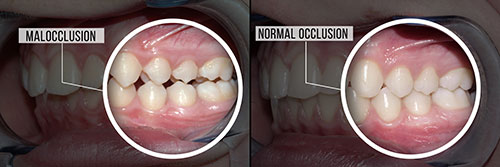
Our Office
8-10 Saddle River Road
Fair Lawn, NJ 07410
Existing Patients: (201) 797-8711
New Patients: (201) 479-0901
Visit Us Online

A healthy occlusion refers to teeth and jaws that are well aligned and in functional harmony. When a malocclusion, more commonly referred to as a “bad bite” is present, either the teeth, the jaws or both are not in the correct positions or proper relationships.
There are many dental issues, which can affect the positions of the teeth and jaws that require orthodontic treatment to resolve. A malocclusion may be due to crowding, spacing, problems with jaw development, or the failure of certain teeth to erupt into their proper positions. Harmful oral habits such as finger sucking or tongue thrusting can also cause bite problems as well as the drifting of teeth into the unrestored spaces left by dental extractions or tooth loss. Sometimes, teeth develop in the jawbone facing in directions that prevent them from erupting at all. These teeth are referred to as impacted.
Both genetic and environmental factors contribute to the development of a malocclusion. Injuries that cause a misalignment of the jaws and diseases such as oral tumors can also play a role in changing the occlusion.
In children, most problems involving the alignment of the teeth and the growth of the jaws can be detected by the time they are in the first or second grade. That is why the American Association of Orthodontists recommends that all children have a check up with an orthodontic specialist no later than age 7. For children, most orthodontic treatment begins between the ages of 9 and 14. However, earlier and interceptive care is sometimes required at a younger age. Likewise, in cases of significant problems involving jaw relationships, orthodontic care may involve treatment throughout growth and development.
It is important to note that a malocclusion can be treated at any age. Today greater numbers of adults are actively seeking treatment for either crooked teeth or jaw problems that have bothered them since childhood, as well as to address teeth that have shifted over time due to extractions, habits, or abnormal bite patterns.
While malocclusions can be observed with a clinical exam, a more comprehensive assessment is required to make a complete diagnosis and to develop the most appropriate plan of care.
Types of Malocclusions
Malocclusions typically fall into three major types based on the kinds of discrepancies in alignment and bite that are present. They can be either due to issues of dental alignment or skeletal jaw disharmonies, or even a combination of both problems.
While most malocclusions will respond to the appropriate orthodontic treatment, some require a combination of orthodontic treatment and orthognathic surgery to improve the skeletal jaw relationships.
